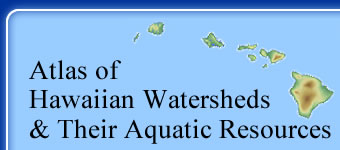
Key to Methods - Current Ratings
In all ratings, it should be generally assumed that if all other things are equal, then a higher score on an individual rating would indicate a watershed or stream that may have more habitat for native species than a watershed or stream with the lower score. For example, all other things equal, if one stream is larger than another stream there would be more available habitat in the stream in the larger stream. Also, if two similar streams empty into the ocean with one flowing directly into the deep ocean waters and the other flowing into a large estuary and then into a shallow bay, more potential nearshore habitat will be influenced by the latter stream.
Most of these ratings are not “proven facts”, but are our interpretation about how streams and their ecosystems work. These general patterns may not hold true for all individual species, but probably benefit overall biodiversity. The component ratings as well as the combined ratings are provided so the reader can assess the overall characteristics of the watershed, stream, or its animals in comparison to other streams on that island or among all streams statewide.
These ratings are not fixed. The biological ratings are based on the presence of species, and additional data are likely to change how a stream scores if additional species are observed. It is also important to realize that the ratings do not consider whether a stream’s water is currently diverted for agriculture or municipal use, whether a stream’s channel has been modified, or whether the stream’s water quality is impaired. This important information is being updated by the Commission on Water Resource Management and the Department of Health and hopefully will be incorporated into future versions of this Atlas.
Each rating has been standardized on a 0 to 10 scale where 0 is the lowest rating and 10 is the highest rating. To accomplish the standardization, after a score for an individual metric was calculated, the lowest score for all the watersheds in the Atlas was subtracted from each score to set the minimum value to zero. Next, the new maximum score was divided into each watershed’s score and resulted in values between 0 and 1. This score was multiplied by 10 to provide the standardized scale. This standardization process was done for each individual rating and also for combined and overall ratings. As a result of the standardization process, each watershed was compared to all other watersheds in the Atlas and, as new data are added to the database, the relative rating of a watershed will need to be re-standardized against all other watersheds. No effort was made to normalize the ratings (adjust the mean rating to 5) because no single normalization process was appropriate for all ratings.